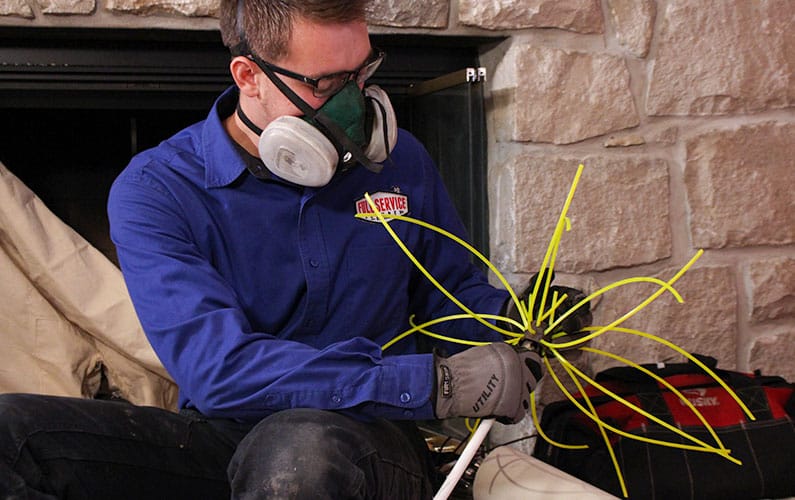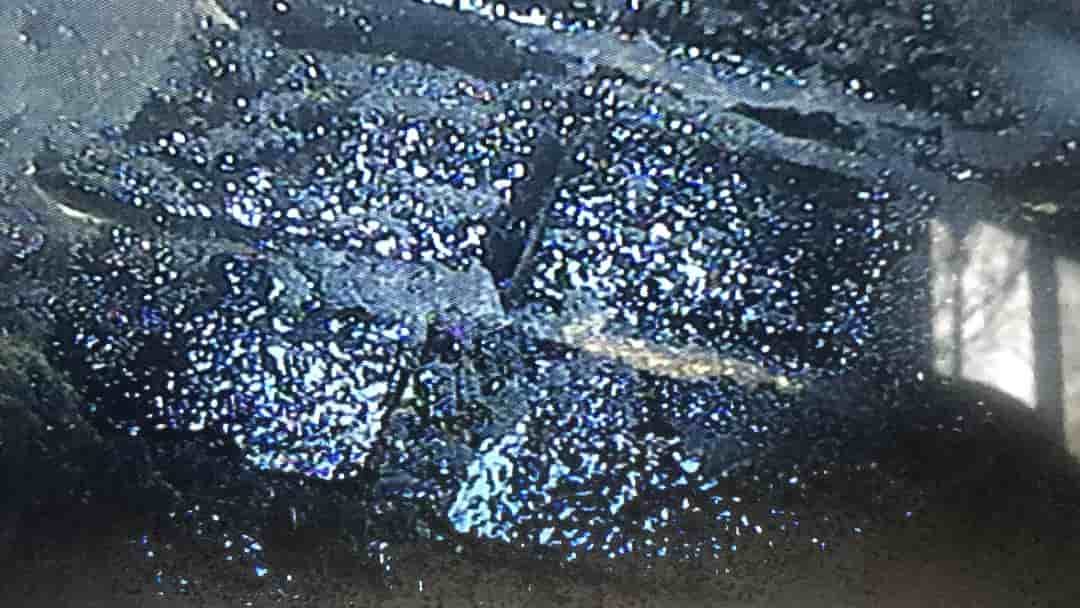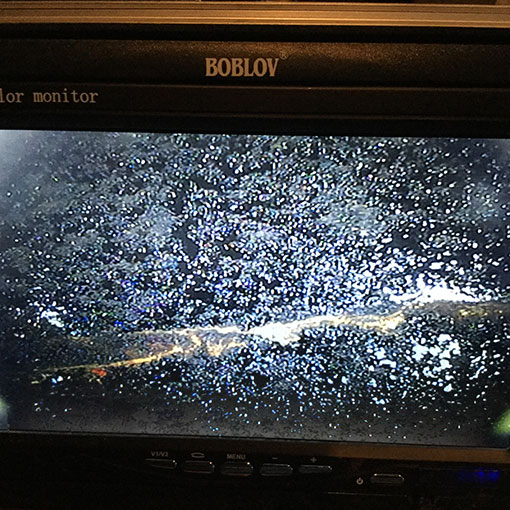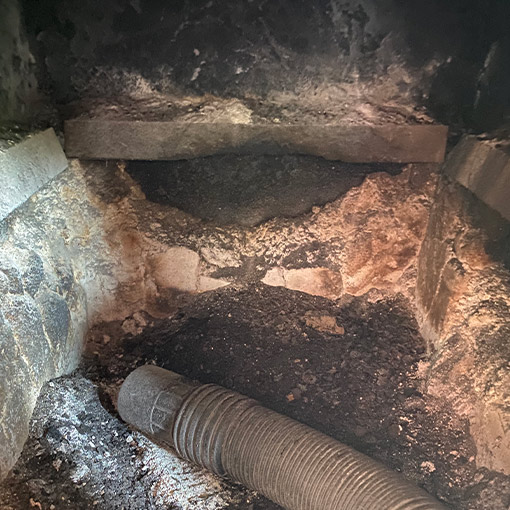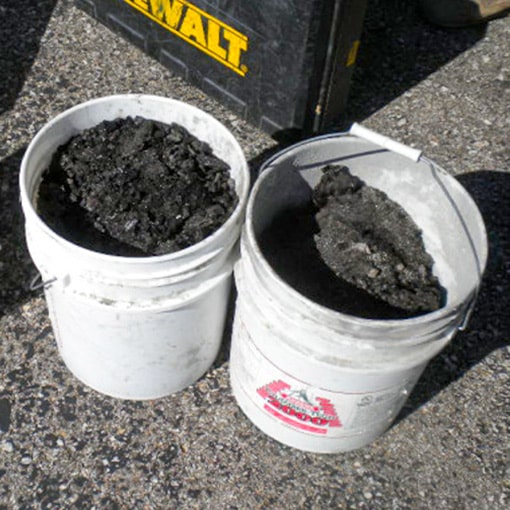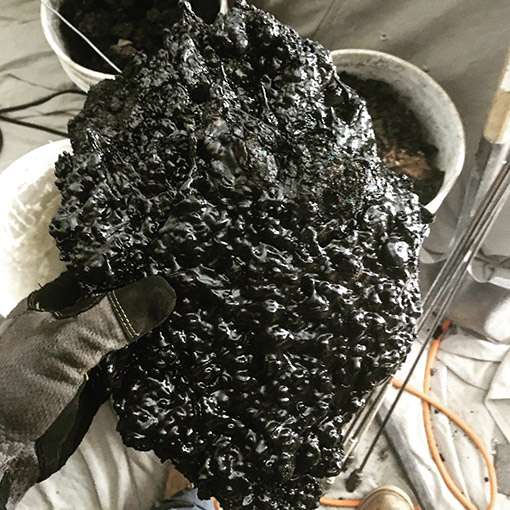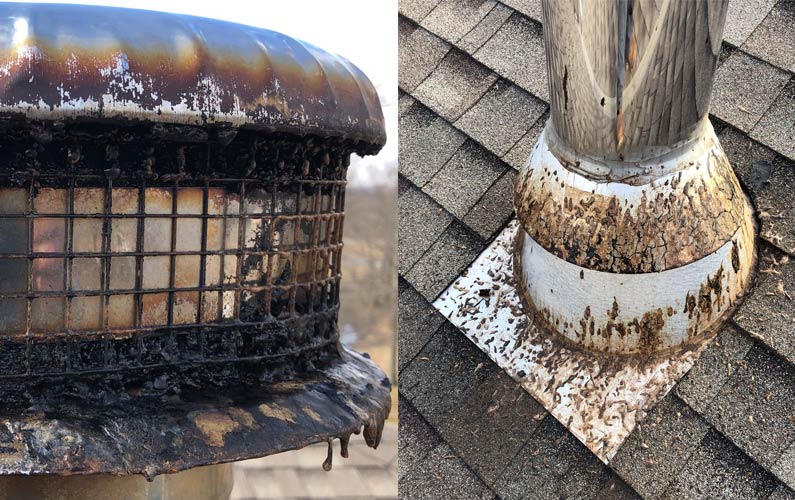It’s falling into your fireplace or stuck to the walls. It can look dusty, puffy, flaky, or oily like tar. Is it soot, is it ash? Not entirely, no, it’s creosote buildup in your chimney, and you can’t stop it! However, it can be managed, reduced, or removed, and this post will explain everything you need to know about it.
In this post, we answer your most commonly asked questions regarding this dirty substance that stinks up the hearth. Including the different types of creosote, what exactly is it, how it forms and why it accumulates inside your fireplace’s exhaust system (aka the chimney).
We even discuss the best way to get rid of creosote buildup from your fireplace and flue tiles.
Let’s get started with one of the most commonly asked questions:
What is Creosote?
Quick Definition: Creosote is the inevitable byproduct of combustion. It happens naturally anytime you burn fossil fuels.
Think of it like wood smoke, condensed.
When we use firewood as our fuel source, the smoky smelling substance develops. It materializes to look differently depending on the stage it’s in when discovered.
What Does Creosote Look Like?
Creosotes color varies from dark ashy gray to a solid black or an extremely dark brown; sometimes with a dirty golden tint. The three types we see appear to be somewhere between a creosote dust and an oily residue that solidifies and eventually hardens. How it usually appears to look:
- Puffed
- Flaky
- Glazed
Tap sides or use arrows to see more images
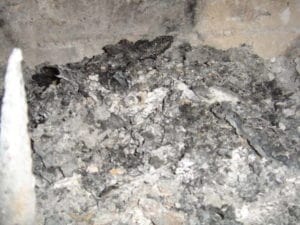
Every time you burn, more layers compound on top, until you have so much buildup that sufficient air can no longer get through.
The speed at which the element builds up varies due to the unique circumstances that change among household conditions and people’s burning habits. (Or should we say bad habits!)
Learn more about the stages of formation below.
Polycyclic Aromatic Hydrocarbons – (PAH)
While we cannot control how particles called PAH’s are released during the combustion process, some things are within our control, like learning how to build a better fire that produces less creosote. This is one of the best ways to prevent chimney fires!
Don’t Let Your Flue Catch Fire!
High heat and flames destroy flues, and chimney fires can quickly spread to other parts of a home. Since a fire in our house is unthinkable, some of our customers even invite us out twice a year, due to heavy use!
Watch a demonstration video below or visit the full post.
What Does Creosote Smell Like?
Most homeowners report that heavy buildup gives off a foul smoky odor, especially in the damp time of year. Some say it smells like fresh asphalt pavement.
Regardless of the faint smell, creosote is corrosive and damages the flue and connector components when left in the system. While there are few household chores as unglamorous as sweeping a chimney, none are more critical to your family’s safety.
How and Why Does it Happen?
Imagine a fire roaring in your firebox. Flames are rising into your chimney, and the smoke goes up and out of your home through the flue. Creosote starts forming during this burning process and cannot be avoided.
The rising vapors and particles mix with other organic compounds that become “creosote” during your blazing fires. The element itself is charred wood particles plus vapors cooled to a liquid, then dried to a semi-solid state.
*See (PAH) – Polycyclic Aromatic Hydrocarbons as mentioned above.
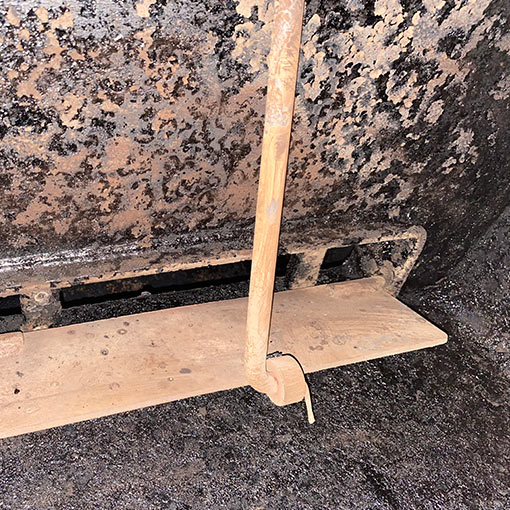
Image shows a fireplace damper with creosote starting to develop in the smoke chamber of a fireplace.
Here’s another way to understand it:
Creosote is wood that has been heated to the point of making smoke but has not engaged in the combustion process. It’s similar to how a gas engine with a choke will get smoky when it’s left on with the engine running.
It’s similar to our gas engine example where the smoke is unburned fuel. The same concept applies where creosote is wood that could have burned but tried to escape through the chimney flue without complete combustion. As a result, the partially combusted particles get stuck on the flue walls and increase over time to become the glazed tar-looking substance we’re all so desperately trying to avoid!
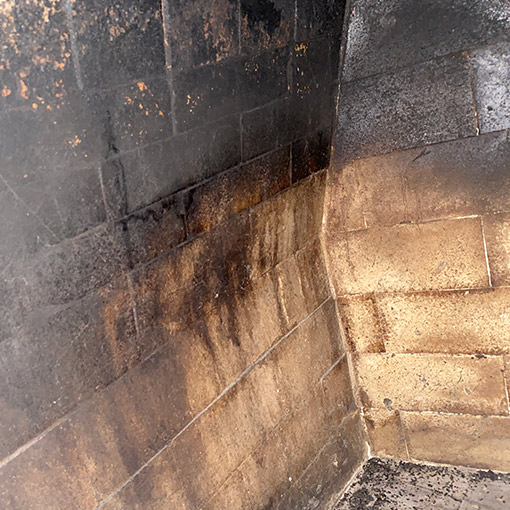
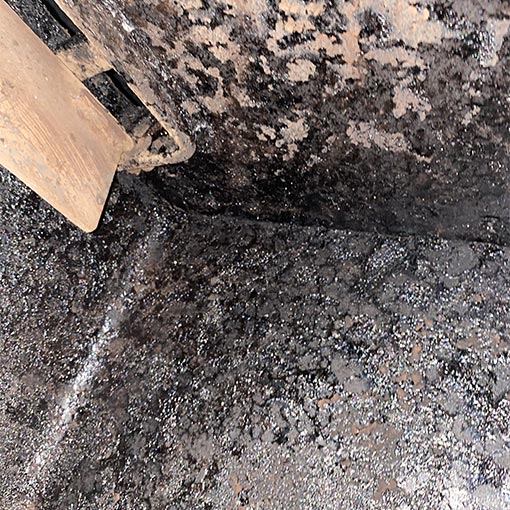
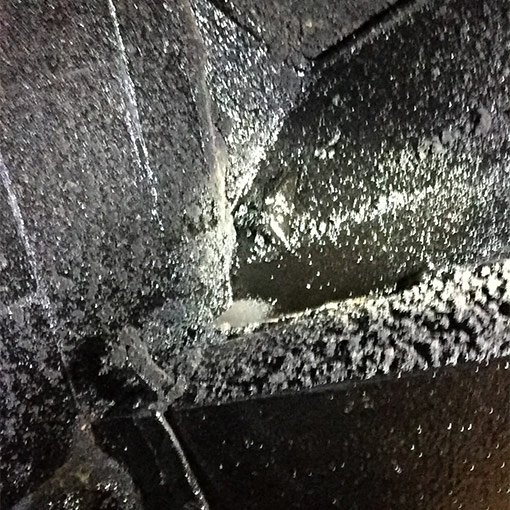
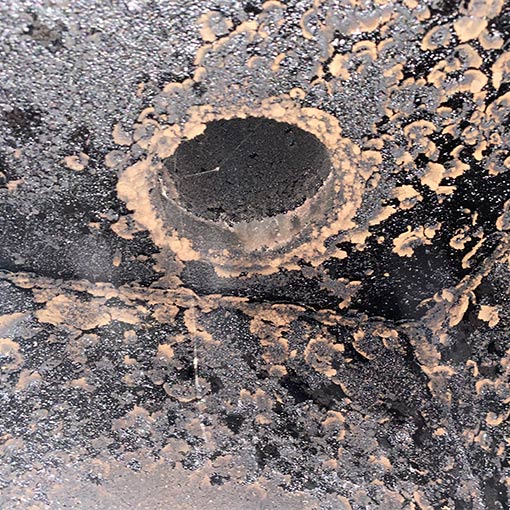
The 3 Degrees of Creosote Compound in Stages
Excessive creosote production is often the result of poor burning practices.
So what is normal creosote buildup? Better yet, how do you know if your chimney is too far gone? If you’re asking these questions, it likely means your chimney inspections aren’t happening seasonally, as they should.
Stage 1: Powdery Dust
Everyone who properly operates a fireplace, wood, or pellet stove will experience this first degree of creosote dust. Suppose your chimney is well-maintained with regular cleanings. In that case, this low level of black powdery dust will not cause you a problem and is usually removed easily with a rotary power sweeping brush.
If you’re certified, you can do this at home with confidence. If not, we suggest calling a professional in your area.
Stage 2: Flakes or Hard Clustered Chunks
We’ve heard people refer to these as “biscuits” because they resemble a crunchy little cluster of tar. Technicians occasionally have to break news to customers, this mid-level situation is sometimes difficult for people to hear because it implies one of two things:
Either there’s a more significant issue with the unit that might be expensive to fix – or – it’s an operator error. Nobody likes to hear they’re doing things wrong, but our job is to help people keep a safe, functioning hearth system and we do what it takes to make that happen.
“Whether you have a wood-stove or a standard hearth, we’re happy to help teach folks the right way to burn! We want to prevent heavy buildup from happening in our customers homes.”
– Robert Berry, Owner / Master Chimney Sweep
Learning how to operate your system correctly pays off.
Every year there are over 22,000 house fires caused by chimneys. Take a look at our helpful list below before you start burning fires in your home; it could save you a pretty penny and a major headache!
In the case of stage 3 heavy glazed build-up, knowing the facts could save lives.
Stage 3: Heavy Glazed Creosote is a severe problem and requires professional intervention.
The reason is the oily black substance has experienced a compounding problem. Over an extended period, without regular cleanings, the vapors and particles released form a solid sheet of glazed creosote that’s nearly impossible to remove.
It’s highly flammable.
The longer it sits, the worse it gets and the harder it becomes to remove.
By consciously operating our wood stoves and fireplaces with smaller fires using seasoned/dry-woods and giving the firebox sufficient air, creosote production is minimized.
Common Issues that Lead to Excessive Build-Up and House Fires
Here’s a Quick Rule of Thumb:
Anything that does not allow your fossil fuels (i.e., coal/pellets/wooden logs/petroleum, etc.) to go through the complete combustion process results in a buildup of creosote in the box, smoke chamber and on the walls of your ceramic flue liner.
As shown in the image excessive buildup is extremely dangerous. DO NOT BURN in a system that has noticeable amounts of creosote forming.
Doing so generates heat that is HOT enough to crack your ceramic flue tiles. Allowing not only fire and smoke but carbon monoxide into your home.
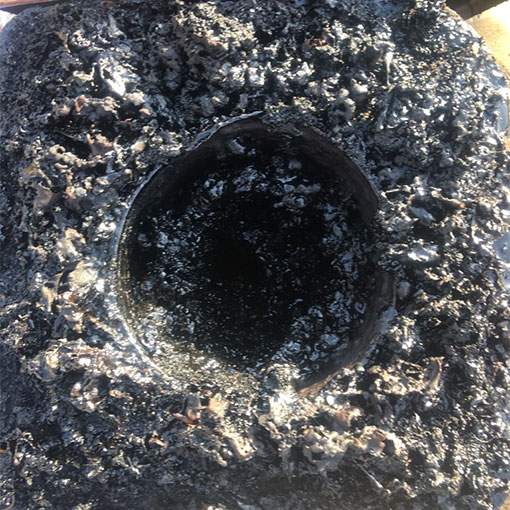
Creosote is literally what makes chimney cleaning necessary. You could even say it’s the entire reason the chimney industry exists!
Watch this demonstration video to see how long it takes for fire to crack ceramic tiles.
Are You Making Any of These Mistakes?
Operator Errors:
- Not opening the damper all the way, restricting the draft and flow of air.
- Burning wood before it’s ready; logs not seasoned properly do not burn well.
- Burning BIG HOT roaring flames is a bad idea and causes excessive creosote.
- Not sweeping the chimney every year as recommended.
- Trying to burn wet logs produces more smoke, soot, and creosote as a result. Your moisture content should be less than 20%.
- “Slumbering”; aka low and slow-burning all night with reduced airflow in an attempt to make the fire last and easy to restart the next morning. NOTE: We do not advise using this method in your stoves, as it produces more creosote!!!
Other Common Problems:
- Home unable to draw the appropriate amount of air to allow complete combustion.
- Air or heating appliances could be competing for air in your hearth room.
- Modern energy-efficient homes can suffer this problem.
- Lack of insulation causes a cold chimney and may not allow for firewood to fully combust.
Chimney Creosote Removal must be part of your annual maintenance routine.
A minimum of one professional chimney cleaning per year is the only way to prevent creosote health and safety problems in your home, as recommended by the NFPA – National Fire Protection Association
Check out this short animated video to get an idea of how we remove this grimey gunk from your chimney!
3rd-Degree Creosote Removal
You’ll find tons of products online advertising a quick fix for creosote. Don’t believe every claim. Do your research, talk to your CSIA Certified Tech and find the solution that fits your situation. What worked for your neighbor may not work for you.
A chimney sweep can try to dissolve the residue, and sometimes it may offer a temporary solution. We’ve had success with a professional product called: PCR Poultice Creosote Remover. Still, we normally advise against it since the sooty glazed material is a dense solid matter.
If the situation reaches this 3rd degree, it may take heavy chains to break the creosote apart!
Usually, it’s not worth the effort or the additional cost. Using chains can even cause more damage to the ceramic flue tiles, rendering your fireplace unsafe for use. Which means you’d essentially be paying twice. We always recommend repairing your chimney the right way, the first time around!
By the time chains and dissolver products are necessary, the chimney needs a complete liner replacement to solve the problem. Visit our steel liner page to learn about the cost of an installation project (which often comes with a manufacturer’s lifetime warranty).
Suggested Reading
Check out this post to see why cleaning your own chimney is not a DIY job, unless you’re a trained professional.
SUMMARY:
Homeowners who use their wood-burning fireplaces frequently ask many questions relating to this strange dark solid matter that remains after the fires are put out. We hope we answered the main questions that people want to know: What it is and how to get rid of creosote buildup. Whether or not the products they see online actually work in removing creosote. The truth is, some work and some don’t; it may not be worth the price to pay or the time it takes to test out a bunch of potentially toxic chemicals when the best option is always regular maintenance.
Remember the substance itself is a hazardous material and you should never handle creosote without the proper protective gear.
Call your local chimney services company and ask about customer loyalty programs. So when it comes time for cleaning creosote from your chimneys every year, you’ll be ready!
